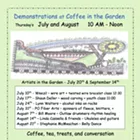SPOKANE -- The combined forces of the sheriff's office and the Spokane Police Department (SPD) has resulted in 86 meth busts already this year.
Last year, 74 sites were busted altogether, and the SPD expects the number of busted labs to possibly grow to 170 by the end of the year.
Lt. Darrell Toombs, commander of the SPD joint drug team and supervisor of the special investigative meth unit, says that most meth-cooks are white males in their 20s and 30s, and that labs are found in all areas of the city and the county. Children are found at about half of the meth sites.
"Unlike other drugs, which basically harm only their users, meth is a serious health danger to neighbors and persons who may have accidental contact with the waste products," says Toombs. Many children end up in protective custody following meth busts.
Toombs estimates that only about 30 percent of the meth being consumed in Spokane is made locally.
The highly addictive drug not only hurts users, but is beginning to take a serious toll on the community, costing landlords, law enforcement, paramedics and fire districts thousands of dollars every day.
Incinerator in Hillyard?
SPOKANE -- An anonymous flier was mailed out last week, claiming the Department of Ecology (Ecology) is building a "toxic waste incinerator" at a site that includes the Tosco Refining Company in Hillyard.
"That is absolutely not correct," says Jani Gilbert, spokesperson for Ecology. "What is going to take place at the site is something called thermal desorption, not incineration."
The Tosco site is bounded by Lincoln Road on the south, Freya Street to the east, North Market Street to the west and the Kaiser Aluminum property to the north. It's contaminated with petroleum products, something thermal desorption is often used to treat.
According to Ecology's guide to thermal desorption, the contaminated soil is heated to between 200-1000 & ordm;F, by which contaminants with low boiling points will turn into gas. The vaporized contaminants are then collected and treated -- not just released into the air. Any contaminates left in the soil after the process are treated separately.
Contamination from petroleum products has been found in the groundwater at the Tosco site at between eight and 13 times the level allowed. Soil in the area is contaminated, too.
Most of the contamination stems from a large oil refinery complex that was located there in the 1930s and '40s. Waste management was less strict back then, and that's how petroleum products ended up in the environment.
Currently, Tosco operates a storage facility at the site, which includes holding tanks for 16,443,000 gallons of automotive fuel.
In 1995, surveys showed that petroleum chemicals could be detected in the groundwater as far as one mile from the site, within the Spokane aquifer. Some area residents received bottled water from Ecology because of the health hazard.
"This is a cleanup effort," says Gilbert. "The public has had almost five years to comment on this project."














